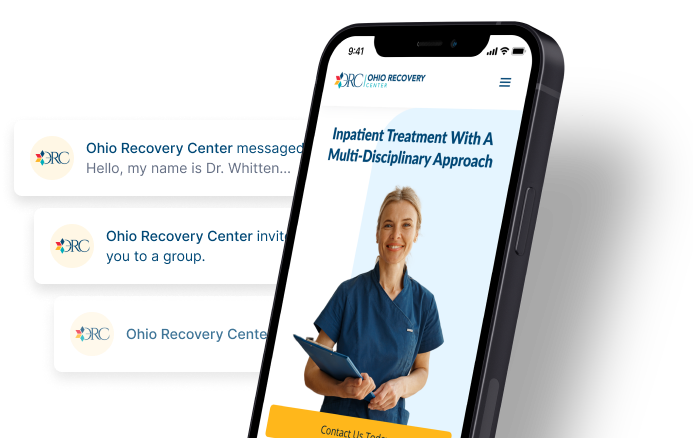Medication-Assisted Treatment At Ohio Recovery Center

Medically Reviewed By: Kimberly Langdon, M.D.
If you are a good candidate for MAT services, your care team at ORC will discuss this evidence-based treatment option with you. Considered “the gold standard” in treating opioid addiction, MAT has proved to be effective in treating both opioid use disorder and alcohol use disorder and in maintaining recovery.

Like treatment for other health conditions, addiction treatment offers options that include medications approved by the U.S. Food and Drug Administration. At ORC, we provide eligible clients with information about and access to these options so that they can make the best choices for their health and recovery.
In order for these medications to be effective in managing substance use disorders and preventing relapse, they are intended to be used as part of a comprehensive treatment program that includes therapy and other supportive treatment options.
MAT can help alleviate withdrawal symptoms and reduce cravings, and participation in ORC’s MAT support group meetings can provide the encouragement, accountability, and inspiration that comes from connecting with peers and sharing life experiences.
Our comprehensive care also includes one-on-one therapy, group therapy, holistic treatment options, aftercare, and more.
Medications Used In Treating Opioid And Alcohol Addictions
There are currently six medications that are FDA-approved for substance use disorder treatment. Three of these medications can treat opioid use disorders (OUD), while three can treat alcohol use disorders (AUD).
Approved medications for treating OUD include buprenorphine, methadone, and naltrexone. Approved medications for treating AUD include acamprosate, disulfiram, and naltrexone.
Our treatment team will provide a full evaluation and assessment to determine the best option for your needs.
MAT For Opioid Use Disorder
In 2021, an estimated 2.5 million U.S. adults met the criteria for opioid use disorder, just one indication of an opioid epidemic that has spanned the past two decades.
Overdoses from opioids are a particular concern, due to high fatality rates. Recently in Ohio, the opioid overdose fatality rate was shown to be double the national average.
MAT is proven safe and effective for OUD treatment, especially when part of a structured, comprehensive treatment program such as ours here at ORC.
Buprenorphine
Buprenorphine is a partial opioid agonist. It can reduce opioid withdrawal symptoms and cravings by binding to the same receptors as opioid drugs such as oxycodone or hydrocodone. Buprenorphine can produce pain relief and euphoric effects in smaller amounts compared to other opioids.
Buprenorphine is currently available as several products, ranging from sublingual tablets (Subutex) to combination products with naloxone (Suboxone). Depending on your substance abuse treatment plan, your treatment provider may prescribe you a different form of the drug.
To start buprenorphine treatment, you should not have taken opioids in the past 24 hours and present with withdrawal symptoms.
Methadone
Methadone is a full opioid agonist that can be more potent than buprenorphine. It can block the effects of opioids and provide pain management in their place.
For methadone to be an effective treatment for opioid dependence, it must first be taken under the supervision of a care provider, such as during a treatment program. Later, the person may be permitted to take methadone at home.
The National Institute on Drug Abuse (NIDA) recommends methadone maintenance for a minimum of 12 months. Some people may require longer or even indefinite treatment depending on the severity of their substance use disorder.
Naltrexone
Naltrexone is an opioid antagonist that can block the pain relief and euphoric effects of opioids. Compared to buprenorphine and methadone, naltrexone may not prevent or relieve opioid withdrawal symptoms.
Naltrexone may be contraindicated (not recommended for use) in clients who are already taking methadone.
MAT For Alcohol Use Disorder
Alcohol use disorder may cause severe withdrawal symptoms when a person attempts to quit drinking. MAT can reduce the severity of withdrawal and prevent people in recovery from relapsing.
Acamprosate
Acamprosate can reduce the desire to drink alcohol. It is thought to work by affecting glutamate levels in the brain, a neurotransmitter that is linked to alcohol withdrawal and cravings.
Acamprosate may not be recommended for people who are still drinking alcohol. People with chronic kidney problems may receive reduced doses.
Acamprosate has been FDA-approved to treat AUD since 2004. A standard dose schedule may involve thrice-daily doses taken orally.
Disulfiram
Disulfiram is a medication that can cause nausea, vomiting, and palpitations when a person drinks alcohol, discouraging them from doing so.
Disulfiram has been FDA-approved to treat alcohol use disorder since 1951. It works by blocking the enzyme aldehyde dehydrogenase (ALDH), which plays a crucial role in alcohol metabolism.
A standard dose schedule may involve 250 milligrams of disulfiram, taken orally once daily.
Naltrexone
Naltrexone can treat alcohol use disorders as well as opioid use disorders. During AUD treatment, it may be given as a pill or injection. Naltrexone can block the sedative effects of alcohol and reduce cravings.
Naltrexone can cause serious side effects if people with an existing dependency start taking the drug. Treatment providers may wait until a person is symptom-free before prescribing the drug.
Naltrexone treatment lasts for about three to four months on average, although treatment length may vary from person to person.
Seek Addiction Treatment At Ohio Recovery Center Today
For more information on our comprehensive residential treatment program, including our medication-assisted treatment options, please contact us today.
- American Journal Of Managed Care - An Overview of Medication-Assisted Treatment for Opioid and Alcohol Use Disorders https://www.ajmc.com/view/an-overview-of-medication-assisted-treatment-for-opioid-and-alcohol-use-disorders
- Department of Health and Human Services - What is the U.S. Opioid Epidemic? https://www.hhs.gov/opioids/about-the-epidemic/index.html
- Food and Drug Administration - Information about Medication-Assisted Treatment (MAT) https://www.fda.gov/drugs/information-drug-class/information-about-medication-assisted-treatment-mat
- Substance Abuse and Mental Health Services Administration - Medication-Assisted Treatment (MAT) https://www.samhsa.gov/medication-assisted-treatment
- Drug and Alcohol Dependence Reports – Trends in opioid overdose fatalities in Cuyahoga County, Ohio: Multi-drug mixtures, the African-American community and carfentanil https://www.ncbi.nlm.nih.gov/pmc/articles/PMC9948855/#:~:text=Ohio%20has%20an%20age%2Dadjusted,Department%20of%20Health%2C%202021).
- National Institute on Drug Abuse (NIDA) – Only 1 in 5 U.S. adults with opioid use disorder received medications to treat it in 2021 https://nida.nih.gov/news-events/news-releases/2023/08/only-1-in-5-us-adults-with-opioid-use-disorder-received-medications-to-treat-it-in-2021

